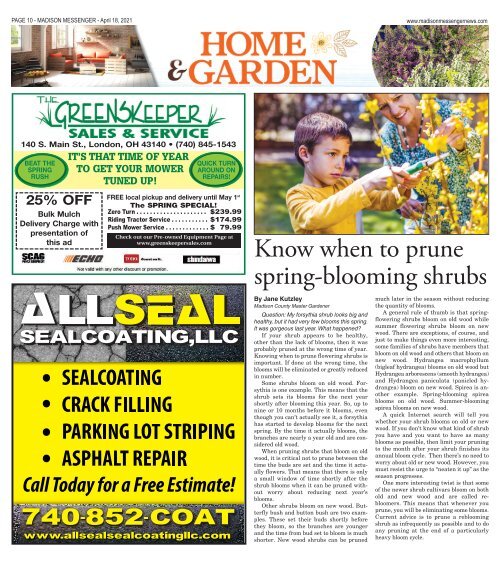Create successful ePaper yourself
Turn your PDF publications into a flip-book with our unique Google optimized e-Paper software.
PAGE 10 - MADISON MESSENGER - <strong>April</strong> 18, <strong>2021</strong><br />
www.madisonmessengernews.com<br />
140 S. Main St., London, OH 43140 • (740) 845-1543<br />
BEAT THE<br />
SPRING<br />
RUSH<br />
25% OFF<br />
Bulk Mulch<br />
Delivery Charge with<br />
presentation of<br />
this ad<br />
IT’S THAT TIME OF YEAR<br />
TO GET YOUR MOWER<br />
TUNED UP!<br />
QUICK TURN<br />
AROUND ON<br />
REPAIRS!<br />
FREE local pickup and delivery until May 1 st<br />
The SPRING SPECIAL!<br />
Zero Zero Turn Turn . . . . Riders.................. . . . . . . . . . . . . . . . . . $ 199.99 $239.99<br />
.<br />
*single cylinder<br />
tractor<br />
Riding Small Tractor Engine Service Riders............. . . . . . . . . . . .<br />
$ 159.99 $174.99<br />
Push Push Mower Mowers......................... Service . . . . . . . . . . . . . $ 59.99 79.99<br />
Check out our Pre-owned Equipment Page at<br />
www.greenskeepersales.com<br />
Know when to prune<br />
spring-blooming shrubs<br />
By Jane Kutzley<br />
<strong>Madison</strong> County Master Gardener<br />
Question: My forsythia shrub looks big and<br />
healthy, but it had very few blooms this spring.<br />
It was gorgeous last year. What happened?<br />
If your shrub appears to be healthy,<br />
other than the lack of blooms, then it was<br />
probably pruned at the wrong time of year.<br />
Knowing when to prune flowering shrubs is<br />
important. If done at the wrong time, the<br />
blooms will be eliminated or greatly reduced<br />
in number.<br />
Some shrubs bloom on old wood. Forsythia<br />
is one example. This means that the<br />
shrub sets its blooms for the next year<br />
shortly after blooming this year. So, up to<br />
nine or 10 months before it blooms, even<br />
though you can’t actually see it, a forsythia<br />
has started to develop blooms for the next<br />
spring. By the time it actually blooms, the<br />
branches are nearly a year old and are considered<br />
old wood.<br />
When pruning shrubs that bloom on old<br />
wood, it is critical not to prune between the<br />
time the buds are set and the time it actually<br />
flowers. That means that there is only<br />
a small window of time shortly after the<br />
shrub blooms when it can be pruned without<br />
worry about reducing next year’s<br />
blooms.<br />
Other shrubs bloom on new wood. Butterfly<br />
bush and button bush are two examples.<br />
These set their buds shortly before<br />
they bloom, so the branches are younger<br />
and the time from bud set to bloom is much<br />
shorter. New wood shrubs can be pruned<br />
much later in the season without reducing<br />
the quantity of blooms.<br />
A general rule of thumb is that springflowering<br />
shrubs bloom on old wood while<br />
summer flowering shrubs bloom on new<br />
wood. There are exceptions, of course, and<br />
just to make things even more interesting,<br />
some families of shrubs have members that<br />
bloom on old wood and others that bloom on<br />
new wood. Hydrangea macrophyllum<br />
(bigleaf hydrangea) blooms on old wood but<br />
Hydrangea arborescens (smooth hydrangea)<br />
and Hydrangea paniculata (panicled hydrangea)<br />
bloom on new wood. Spirea is another<br />
example. Spring-blooming spirea<br />
blooms on old wood. Summer-blooming<br />
spirea blooms on new wood.<br />
A quick Internet search will tell you<br />
whether your shrub blooms on old or new<br />
wood. If you don’t know what kind of shrub<br />
you have and you want to have as many<br />
blooms as possible, then limit your pruning<br />
to the month after your shrub finishes its<br />
annual bloom cycle. Then there’s no need to<br />
worry about old or new wood. However, you<br />
must resist the urge to “neaten it up” as the<br />
season progresses.<br />
One more interesting twist is that some<br />
of the newer shrub cultivars bloom on both<br />
old and new wood and are called rebloomers.<br />
This means that whenever you<br />
prune, you will be eliminating some blooms.<br />
Current advice is to prune a reblooming<br />
shrub as infrequently as possible and to do<br />
any pruning at the end of a particularly<br />
heavy bloom cycle.


















